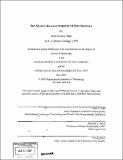The marine biogeochemistry of zinc isotopes
Author(s)
John, Seth G
DownloadFull printable version (9.198Mb)
Alternative title
Marine biogeochemistry of Zn isotopes
Other Contributors
Woods Hole Oceanographic Institution.
Advisor
Edward A. Boyle.
Terms of use
Metadata
Show full item recordAbstract
Zinc (Zn) stable isotopes can record information about important oceanographic processes. This thesis presents data on Zn isotopes in anthropogenic materials, hydrothermal fluids and minerals, cultured marine phytoplankton, natural plankton, and seawater. By measuring Zn isotopes in a diverse array of marine samples, we hope to understand how Zn isotopes are fractionated in the oceans and how Zn isotopes may be used as tracers of marine biogeochemical processes. Common forms of anthropogenic Zn had [delta]66Zn from +0.08 %o to +0.32 %o, a range similar to Zn ores and terrigenous materials. Larger variations were discovered in hydrothermal fluids and minerals, with hydrothermal fluids ranging in 666Zn from 0.02 %o to +0.93 %o, and chimney minerals ranging from -0.09 %o to +1.17 %o. Lower-temperature vent systems had higher [delta]666Zn values, suggesting that precipitation of isotopically light Zn sulfides drives much of the Zn isotope fractionation in hydrothermal systems. In cultured diatoms, a relationship was discovered between Zn transport by either high-affinity or low-affinity uptake pathways, and the magnitude of Zn isotope fractionation. We established isotope effects of [delta]66Zn = -0.2 %o for high-affinity uptake and [delta]66Zn = -0.8 %o for low-affinity uptake. This work is the first to describe the molecular basis for biological fractionation of transition metals. Biological fractionation of Zn isotopes under natural conditions was investigated by measuring Zn isotopes in plankton collected in the Peru Upwelling Region and around the world. (cont.) Seawater dissolved Zn isotopes also reflect the chemical and biological cycling of Zn. The [delta]66Zn of deep seawater in the North Pacific and North Atlantic is about 0.5%0, and the dissolved [delta]66Zn gets lighter in the upper water column. This is unexpected based our observations of a biological preference for uptake of light Zn isotopes, and suggests that Zn transport to deep waters may occur by Zn adsorption to sinking particles rather than as primary biological Zn. The thesis, by presenting data on several important aspects of Zn isotope cycling in the oceans, lays the groundwork for further use of Zn isotopes as a marine biogeochemical tracer.
Description
Thesis (Ph. D.)--Joint Program in Chemical Oceanography (Massachusetts Institute of Technology, Dept. of Earth, Atmospheric, and Planetary Sciences; and the Woods Hole Oceanographic Institution), 2007. Includes bibliographical references.
Date issued
2007Department
Joint Program in Chemical Oceanography; Woods Hole Oceanographic Institution; Massachusetts Institute of Technology. Department of Earth, Atmospheric, and Planetary SciencesPublisher
Massachusetts Institute of Technology
Keywords
Earth, Atmospheric, and Planetary Sciences., Joint Program in Chemical Oceanography., Woods Hole Oceanographic Institution.